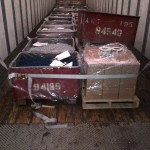Free Packaging Tips and Tricks
Today’s modern freight carriers require that packaging and freight loads be properly secured and organized. This helps to ensure that a shipment arrives safely and without any damage. The good news is that it is easy to protect a shipment from damage when the packaging is done in the right way. Here are a few simple examples of how to properly package a shipment. As a note of caution, many of today’s freight carriers will actually refuse shipment if a load is packaged improperly. This is often due to the fact that poorly packaged loads can void a carrier’s liability for damage.
Non-Fragile Items Can Be Created
The first step in effectively packaging items for delivery is to determine whether they are fragile or breakable. In most cases non-fragile items can be crated or palletized but should still be done so with caution. Conversely, breakable items can include everything from computer equipment to glass items as well as household goods and even small furniture and electronics. Items that are typically not breakable include everything from paper products to clothing and footwear in addition to canned goods and machine parts. Either way, know in advance how fragile your shipment is in order to make a more informed decision about all of the delivery options available.
Drivers are Able to Use a Pallet Jack
It is also important to remember that all items that are loose should be safely contained within a box, crate or carton or some other type of container that will offer protection. Very few carriers today will accept items that are loose or not properly containerized. Especially of concern is heavy machinery or multiple boxes. These types of loads should be securely placed on a pallet or secured within a crate so that truck drivers are able to use a pallet jack more effectively. Heavier duty items such as lawnmowers, refrigerators, ovens, dishwashers engines, compressors and even large furniture and televisions will typically enjoy better and safer delivery by being created or pelletized.
Fragile and Delicate Pieces
When packing items that are fragile or breakable it is best to use sturdy new boxes or similar containers that will protect these items. Using bubble wrap, rolled foam or foam pillows as well as other similar padding can help to protect even the most fragile of items. With fragile and delicate pieces it is best to make sure that there will be no movement within the box. When items are well secured and properly padded even the most fragile of pieces will handle a short or long journey well. Finally, when palletizing freight, make sure that the pallets are in good condition and that they can handle the weight involved. Items are best secured to a pallet using shrink-wrap. Contact Hotline for today to learn more about less-than-full-load shipments!


